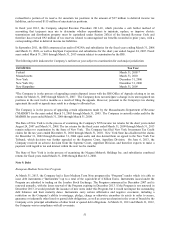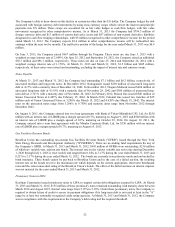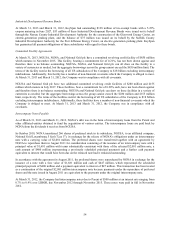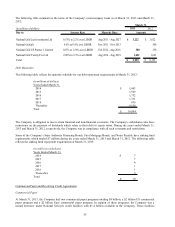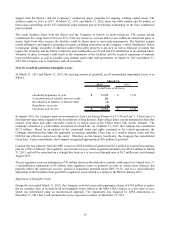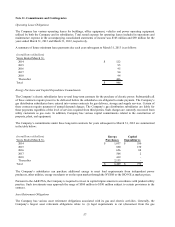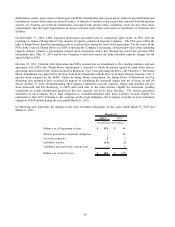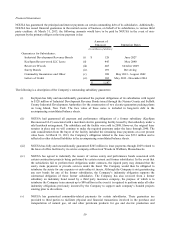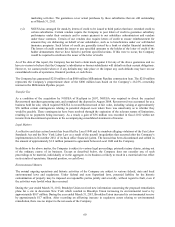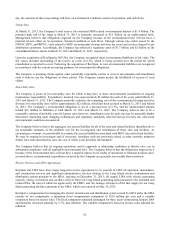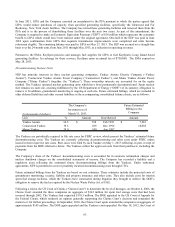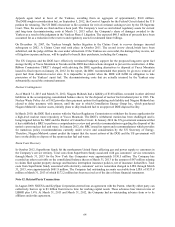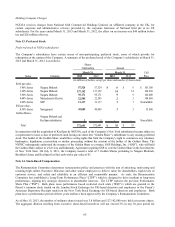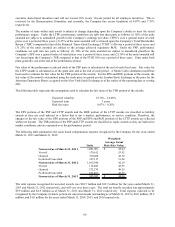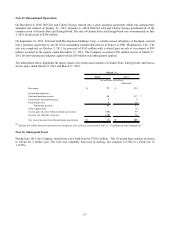National Grid 2013 Annual Report Download - page 62
Download and view the complete annual report
Please find page 62 of the 2013 National Grid annual report below. You can navigate through the pages in the report by either clicking on the pages listed below, or by using the keyword search tool below to find specific information within the annual report.61
On April 26, 2013, General Electric ("GE") filed a lawsuit against the Niagara Mohawk seeking contribution under the
Comprehensive Environmental Response, Compensation, and Liability Act for an unspecified portion of GE’ s alleged
response costs incurred in remediating polychlorinated biphenyl (“PCB”) contamination in the Hudson River. GE alleges
that Niagara Mohawk’ s removal of the Fort Edward Dam in 1973 resulted in the migration of sediments, contaminated
with PCBs released into the environment by GE, downstream of the former dam’ s location. Niagara Mohawk denies
liability and is defending this action.
Air
Our generating facilities are subject to increasingly stringent emissions limitations under current and anticipated future
requirements of the United States Environmental Protection Agency (“USEPA”) and the DEC. In addition to efforts to
improve both ozone and particulate matter air quality, there has been an increased focus on greenhouse gas emissions in
recent years. Our previous investments in low NOx boiler combustion modifications, the use of natural gas firing
systems at our steam electric generating stations, and the compliance flexibility available under cap and trade programs
have enabled the Company to achieve its prior emission reductions in a cost-effective manner. Ongoing investments
include the installation of enhanced NOx controls and efficiency improvement projects at certain of our Long Island
based electric generating facilities. The total cost of these improvements is estimated to be approximately $92 million
($72 million had been placed in service and the Company expects to spend another $20 million); a mechanism for
recovery from LIPA of these investments has been established. We are currently developing a compliance strategy to
address anticipated future requirements. At this time, we are unable to predict what effect, if any, these future
requirements will have on our financial condition, results of operations, and cash flows.
Water
Additional capital expenditures associated with the renewal of the surface water discharge permits for our power plants
will likely be required by the DEC at each of the Long Island power plants pursuant to Section 316 of the Clean Water
Act to mitigate the plants’ alleged cooling water system impacts to aquatic organisms. We are currently engaged in
discussions with the DEC and environmental groups regarding the nature of capital upgrades or other mitigation
measures necessary to reduce any impacts. Although these discussions have been productive and have led to mutually
agreeable final permits at some of the plants, it is possible that the determination of required capital improvements and
the issuance of final renewal permits for the remaining plants could involve adjudicatory hearings among the Company,
the agency, and the environmental groups. Capital costs for expected mitigation requirements at the plants had been
estimated on the order of approximately $100 million and did not anticipate a need for cooling towers at any of the
plants. Depending on the outcome of the adjudicatory process, which could extend beyond the next fiscal year, ultimate
costs could be substantially higher. Costs associated with any finally ordered capital improvements would be
reimbursable from LIPA under the PSA.
Land, Manufactured Gas Plants and Related Facilities
Federal and state environmental regulators, as well as private parties, have alleged that several of the Company’ s
subsidiaries are potentially responsible parties under Superfund laws for the remediation of numerous contaminated sites
in New York and New England. The Company’ s greatest potential Superfund liabilities relate to MGP facilities formerly
owned or operated by its subsidiaries or their predecessors. MGP byproducts included fuel oils, hydrocarbons, coal tar,
purifier waste and other waste products which may pose a risk to human health and the environment.
Since July 12, 2006, several lawsuits have been filed which allege damages resulting from contamination associated with
the historic operations of a former manufactured gas plant located in Bay Shore, New York. KeySpan has been
conducting a remediation at this location pursuant to Administrative Order on Consent (“ACO”) with the New York
State Department of Environmental Conservation (“DEC”). KeySpan intends to contest these proceedings vigorously.
On February 8, 2007, we received a Notice of Intent to File Suit from the AG against KeySpan and four other companies
in connection with the cleanup of historical contamination found in certain lands located in Greenpoint, Brooklyn and in
an adjoining waterway. KeySpan has previously agreed to remediate portions of the properties referenced in this notice
and will work cooperatively with the DEC and AG to address environmental conditions associated with the remainder of
the properties. KeySpan has entered into an ACO with the DEC for the land-based sites. The United States
Environmental Protection Agency (“EPA”) assumed control of the waterway and, on September 29, 2010, listed this site
on its National Priorities List of Superfund sites. We signed a consent decree with the EPA on July 7, 2011 and are
currently performing a Remedial Investigation and Feasibility Study. At this time, we are unable to predict what effect, if


